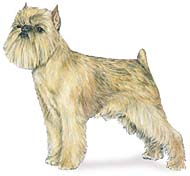INSTANT PROMOTION - LIMITED TIME OFFER - GET YOUR PUPPY COUPON TODAY
Hicksville: 516-938-7877
Lynbrook: 516-825-7877
Hicksville: 516-938-7877
Lynbrook: 516-825-7877
Currently we do not have any Brussels Griffon Puppies available.
Please complete the form below to be notified when they are back in our stores.

Other Names: Griffon Belge, Griffon Bruxellois, Belgian Griffon, Petit Brabonçon, Piccolo Branbantino
Type: Companion Dog
Height: All variations are 7 – 10 inches. Weight: The Brussels Griffon and the Petit Brabonçon are 6 – 12 lbs., while the Belgian Griffon can be of two varieties: up to 6.5 lbs., and up to 11 lbs.
Colors: Red, Belgian Griffon: Black, black and tan, or red, black and grizzle. Brussels Griffon: Completely and clearly red. Petit Brabonçon: Red, red and black, red, black, and grizzle, black and tan, or just black. The Petit Brabonçon can be any of the Griffon colors, while the other two varieties are separated by the red color. Coat: The rough coat of the Griffon is harsh and wiry, and often bushy. The smooth coat is soft, smooth, and dense.
Temperament: Brussels Griffons are lively, obedient, and love to be around their owner. They do not do well by themselves in a backyard, and need to be near their owner much of the time. They enjoy and need association with people from an early age, and do not tend to be aggressive. They are an intelligent, cheerful dog, and they have the disposition of a terrier. They are alert and sometimes too confident. They can be difficult to train, and some do not get along well with children. They are mostly a one-person dog. With Children: Okay. Older children who help train are okay, but the Griffon has a strong tendency to stick closely to one person, possibly becoming defensive around another who steals their person’s attention. Supervision is a must around children. With Pets: Yes, the Griffons are fine with other pets and get along well. But they may try to take on an animal much larger than themselves due to their overbearing confidence, therefore supervision is appropriate when around larger animals.
Watch-dog: High. They are reserved with strangers, and are very alert. Guard-dog: Low. Brussels owners must be careful because this breed is not afraid of dominating another dog, even if the other dog is several times their size. So although they can defend, they are not appropriately sized to do so.
Care and Training: A Brussels Griffon smooth coat needs brushing two to three times a week. The rough coat needs to be hand stripped by a professional groomer. Brussels Griffons can obtain their exercise indoors, but will enjoy daily walks. Training should start early and needs to be consistent and precise. Although they are stubborn they are sensitive to being rushed or to overbearing training techniques. Learning Rate: High. Brussels Griffons are said to be very intelligent. Obedience – Low. Griffons may be difficult to train. Problem Solving – Very High.
Activity: High. They are energetic little dogs. Living Environment: Apartment is suitable if regular exercise is provided. Owners should be patient, precise and enjoy a busy, amusing dog. As long as there is enough space to follow, the Brussels Griffon will go with their owners anywhere. The best owner for this breed would be a dedicated owner who lives in a suburban or city area.
Health Issues: Brussels Griffons have difficulty in becoming pregnant and delivering newborns. Only 60 percent of the puppies survive. Other health concerns include brachycephalic syndrome, cleft palate, eye problems, and respiratory problems.
Life Span: 12 – 15 years. Brussels live well into their teen years. Litter Size: 1 – 3 puppies.
Country of Origin: Belgium History: A painting by Jan Van Eyck portrayed the Brussels Griffon in 1434. Once the Brussels Griffon was known as the “Belgian street urchin” who was often found killing rats in stables. Bred for their ratting abilities, their heritage is probably largely due to the Affenpinscher, as well as the Dutch Pug, Ruby English Toy Spaniel, Yorkshire Terrier and Irish Terriers. It is said that even more breeds were added to the mix including Barbets, Smoushounds, and Pekignese. Originally, they were mostly a peasant’s dog, riding as passengers on cabs on the seat next to the cab driver. This created more popularity for the little dog, and soon it made its way to royalty. French King Henry III, Belgian Queen Henrietta Maria and Queen Astrid were all fans of the breed. Most sources agree that after the breed was mixed with the English Toy Spaniel, however, its nose became shorter and its ratting abilities were depleted. Having Pug blood did not help either. Back then, though, the breed was probably the size of a Fox Terrier and with a longer muzzle, all of them being rough-coated. After which, the two types of coats were developed. The two were the rough coats and smooth coats. In Brussels, Belgium, the Griffon Bruzellois was highly popular between World War I and World War II, literally having thousands in Brussels alone. Once the Griffon had developed into distinct coat variations, the breed was divided into three categories: smooth coated, rough coated reds, and roughs of other colors. The smooth coats are called Petit Brabonçons; the rough reds are called Brussels Griffons, and the roughs of other colors are called Belgian Griffons. If this wasn’t confusing enough, Belgium considered all three to be separate breeds. But in the United States and other countries, the breeds are considered one in the same. They made their way to England in the mid 1800s, and reached the U.S. near the early 1900s. Brussels Griffons remain largely celebrated in Europe to this day.
First Registered by the AKC: 1910 AKC Group: Toy Class: Toy Registries: AKC, ANKC, CKC, FCI (Group 9), KC (GB), UKC